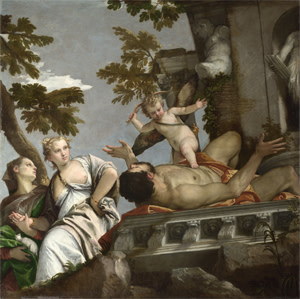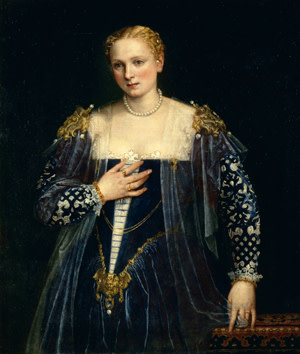Veronese’s virtues in painting

Simply sign up to the Life & Arts myFT Digest -- delivered directly to your inbox.
Grappling with his portrait of Greta Moll in 1908, Matisse demanded 30 hours of sittings to produce a likeness of the beautiful young woman, which delighted her but infuriated him because “I had not managed to catch her statuesque aspect”. His dissatisfaction centred on a memory of “La Bella Nani”, Veronese’s shimmering portrait of a blonde woman with too small a head but a voluptuous form and light reddish skin, all exactly like Moll.
After the 10th sitting, Matisse ran to the Louvre, meticulously examined Veronese’s stately girl in gold-embroidered, pearl-encrusted blue velvet, then hurried back to simplify and flatten his own composition, accentuating Moll’s bold features and big forearms. Returning the next day, Moll was devastated, though the abstracted depiction, now at Tate, was soon acknowledged a landmark in avant-garde portraiture.
Veronese is a painter’s painter. Sweeping designs, sumptuous surfaces, theatrical command of space and light, made him the reference point throughout history for artists of the grand manner: Rubens, Delacroix, Renoir. He has always been recognised as the Renaissance’s supreme colourist, just as Matisse is the outstanding colourist of modernism. London now has an unusual opportunity to compare these great masters of decorative painting separated by four centuries: the capital’s main exhibitions this spring are Veronese: Magnificence in Renaissance Venice, Britain’s first Veronese show, at the National Gallery, and Tate’s Henri Matisse: The Cut-outs, opening next month.
Among many superb loans, Veronese has the Louvre’s “La Bella Nani”, Edinburgh’s twilight stunner “Venus, Mars and Cupid”, which brilliantly contrasts the god of war’s metallic armour with Venus’s soft, translucent flesh, and monumental altarpieces never before seen in Britain. Venice’s “The Mystic Marriage of St Catherine” is a textural rainbow of white marble wrapped in red drapery, the saint’s subtle skin tones and richly patterned dress, and diaphanous silver-gold robed angels tumbling on to stone steps. Verona’s four-metre “The Martyrdom of St George” is a stage set, inviting us to look up past the altar to the saint, kneeling to be beheaded, then to follow his gaze through ultramarine skies to a heavenly light – intense, pure, blazing.
Even in monochrome, Veronese is flamboyant. “Portrait of a Gentleman” from 1555, the year the artist set out from his native Verona to make his name in Venice, transforms a subdued image of a retiring man in black into drama by opening out the sitter’s coat and holding it against a large fluted column, to reveal a lavish lynx-fur lining, dexterously sketched in differing shades of white punctuated by small black dots. The three-quarter format and feathery brushstrokes are indebted to Titian but, already, the architectural setting and attention to wealth and splendour are Veronese’s distinctive calling cards.

Not yet 30, Veronese rapidly developed beyond such single portraits by introducing a new genre: family groups inserted into religious narratives. The Louvre’s “The Supper at Emmaus” (1555) focused on the moment when two disciples recognise the resurrected Christ, is the first, most beautiful example of a conventional iconographic scene interrupted and enlivened by onlookers. An aristocratic couple in richly coloured robes and their children, tenderly playing with a dog, behold the sacred scene as if it is re-enacted before them by an act of grace, made real by the vision of their inner eye and devotion. The glamorous family inhabit the same space as the religious figures with conviction; placing them against classical columns and portico, Veronese achieved opulent, majestic effects that, wrote art historian Bernard Berenson in 1894, “helped to make the great of the world aware of themselves and to live in ways worthy of their status”.
Subsequent religious paintings carry similar busy, secular charges. The Prado’s jewel-like “Finding of Moses” is a courtly scene on a Verona riverbank, with the Pharoah’s daughter a 16th-century princess in damask, surrounded by ladies-in-waiting, a dwarf, a black servant draped in orange. Two renderings of “The Adoration of the Kings”, reunited here for the first time since they left Veronese’s studio in 1573, place the holy family on an eccentric wooden scaffold attached to classical ruins; kings in gold, crimson, blue silk, bearing delicate vessels in precious materials, pageboys holding turbans, camels, horses, an oddly refined shepherd in a feathered hat, are depicted in lively, flickering marks, light reflected in waves of colour on the glistening surfaces of the fabrics.
Veronese was summoned by the Inquisition that year, to explain why he had included a jester with a parrot, as well as “drunkards, German halberdiers, dwarfs and other lewd things” in a “Last Supper”. “Per ornamenti, come si fa” – “for ornament, as one does” – Veronese answered. “If in a painting there is a space left over, I fill it with figures.”
Let off by the Inquisition – he was merely ordered to replace a dog with a depiction of Mary Magdalen – Veronese has been haunted ever since by his own words. Is he more than an agreeable filler of spaces, in vivid, arbitrarily decorative colour schemes, who came to define the splendour of the Venetians to themselves and then to history?
“It may be doubted whether, as a mere painter, Paolo Veronese has ever been surpassed,” Berenson argued. By then, the National Gallery had acquired the 10 Veroneses, of varying quality, that are the bedrock of this show, including “The Family of Darius Before Alexander”, bought from Count Vettore Pisani in 1857 for 360,000 Austrian francs. Coveted among collectors for centuries, this was called “the greatest Veronese in Italy” by Ruskin, its narrative flair and abundant detail perfectly answering Victorian taste. Smooth, even, crystalline in its precision, the depiction of the magnanimous gesture of Alexander to the defeated Persian royalty, observed by a curious retinue headed by a monkey trying to unlock its chain, is a masterpiece of spectacle that at once shows Veronese’s magnificence and his limitations.
Lacking the tragic poetry of Titian, the fervour of Tintoretto, or much intellectual curiosity, he is the Renaissance Venetian who chimes least easily with today’s sensibility. No exhibition can change that yet it is a tribute to this finely judged show that by its end, one can feel, as Henry James did a century ago, the pleasure of walking “out of the noonday dusk of Trafalgar Square …and in one of the chambers of the National Gallery see[ing] the family of Darius rustling and pleading and weeping at the feet of Alexander. Alexander is a beautiful young Venetian in crimson pantaloons, and the picture sends a glow into the cold London twilight. You may sit before it for an hour and dream you are floating to the watergate of the Ducal Palace”.
‘Veronese: Magnificence in Renaissance Venice’, sponsored by Credit Suisse, National Gallery, London, to June 15, nationalgallery.org.uk
Comments